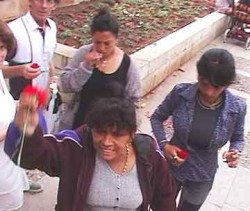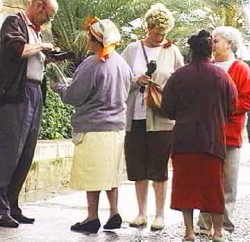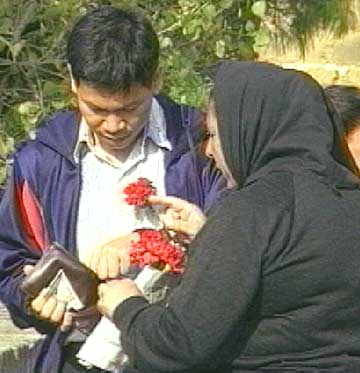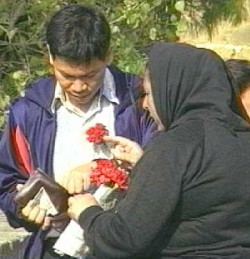
The Offer of a Flower is a Foil for Filching
Palma de Mallorca, Spain— Bob and I trailed a trio of young women through Palma’s shopping district. Working separately but near each other, they halfheartedly approached a seemingly random selection of meandering tourists. Most ignored the women’s overtures, but one amiable couple paused with interest.
Bob filmed the scene and I alternated between watching the scam and watching Bob’s back. He was balancing a huge camera on his shoulder and I carried the ponderous tripod and brick-like battery. Neither of us could hear the exchange, if there was one, but the con artist must have made her desires clear. The male tourist had his wallet out, then replaced it in his front shorts pocket. Bob and I could see the pocket from where we stood, behind him. As we watched (and filmed), the con woman reached across the man and put her hand into his pocket! She made no particular effort to disguise her move, and the man reacted not at all. How brazen she was, and how trusting was he. How well she read him.


Suddenly, I was roughly pushed. I had failed to notice that one of the thief’s partners had observed our camera focused on her teammate. She raised her hand to push away the camera and I blocked her with my arm. Her fist crashed down on my wrist, breaking my stainless-steel watchband.
“No photo!” she shouted.
Now Bob swung around and looked at the woman through his lens.
“No photo!” she yelled again, and ineffectively waved a tissue at the camera. Then she swiveled, bent, and rose in one fluid motion, and hefted a massive rock. In a classic pitcher’s posture—or was she about to throw like a girl?—she aimed for the camera lens. A frame captured from the video makes a lovely portrait of her, rock poised in one hand, dainty bouquet of carnations in the other.
Wound up and ready to smash our camera, she bared her teeth and raised one foot.
“Hey-hey-hey!” commanded a male voice behind us, or something to that effect in the woman’s language. A cloud of dust rose and the earth shook as her boulder plunked to the ground.
With a sneer, the would-be destroyer turned and rejoined her companions, who had just finished their scam. Bob and I caught up with the victims.
“First they pretended to give us the flower,” the woman said cheerily, “but then they asked for one peseta.” She and her husband were both smiling, amused by the bold stunt and pleased to be interviewed.
“When I gave her some money, she gave it back,” the husband cut in. “She said no-no-no. And she put her hand in my pocket and the hand came out. I only lost 400 pesetas.”
That explained their jovial mood.

Palma de Mallorca has long been a favorite holiday destination for Germans and Swedes, and for Europeans in general. Many British retire to Mallorca, or have second homes there. Ferries bring daytrippers from mainland Spain, and cruise ships regularly dump sightseers by the thousands to bask in this balmy Spanish paradise. Its beaches and nightclubs are a perennial draw, and have been long before the spotlight hit Ibiza. Low-lying criminals, too, are attracted to Palma’s easy-going lifestyle and laid-back law enforcement.
“Claveleras, that’s all we do!” one of Palma’s police officers told us in exasperation. Clavel means carnation; claveleras are the thieves who use them. The police officer had stopped us from filming an incident at the claveleras’ request.

“Why do you protect them?” I asked the cop. “They’ve been here for years!”
“It’s not possible to arrest them,” the officer said. “They only took 200 euros. It’s not enough. They must take 300.”
“But they’ve been doing this for years! It’s ruining Palma’s reputation.”
“Yes. I know all of them. Their names, their addresses.”
“Then why don’t you let a tourist,” Bob said, “like me, put 400 euros in his pocket, let them take it, and then you can arrest them.”
The conversation circled unsatisfactorily, revealing firewalls between politicians, law enforcement, journalists, tourist bureau, and the unfortunate tourists. We, like the police, threw up our hands.

We met Douglas and Evelyn Massie outside the fortress, yet another pair of British victims. Their nemesis was a young woman, perhaps in her 30s, who wore track pants and a jacket—an updated wardrobe.
“Would you like to go to the police station?” we asked them. “You won’t get your money back, but a police report might help you with a claim to your insurance company and we’ll translate for you.”

At the police station we were perfunctorily handed a poorly-photocopied theft report form in English. Heading the list of common M.O.s was “woman with carnation.” The Massies duly Xed the box while Bob and I marveled at a system that could officially acknowledge and simultaneously condone such activities. After all, we’d observed this swindle for ten years: same women, same technique, same locations.
A tattered photo album was put before the Massies without comment. Page after page of female mug shots stared up from under plastic. There was the grandmother gang, and there a pair of tall sisters we’d watched. There was the Massies’ snaggle-toothed tormentor and there, grinning wryly, was our infamous rock thrower.

The Massies huddled judiciously over their theft report and laboriously printed out in block letters a story that would likely never be read.
But their tale will be told—by the Massies and by thousands of people who have had the good fortune to visit Palma. The story begins: There was an old woman, who gave me a flower…
This is Part 3 of The Flower Gift Lift. Read Part 1Â Â Â —Â Â Â Â Part 2
Excerpt from Travel Advisory: How to Avoid Thefts, Cons, and Street Scams
Chapter Seven: Scams—By the Devious Strategist







